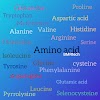Glutamine | Introduction | History | properties...
GLUTAMINE AMINO ACID
History-In 1883, German chemists Ernst. Schulze and E.
Bosshard isolated L-glutamine from the juice of sugarbeets. It is the most
common amino acid in human blood and a key component of proteins. In 1886,
Schulze was also the first to isolate L-arginine, in this case from lupin
seedlings. It is also an important amino
acid in protein biosynthesis.
Introduction- Glutamine is an α-amino acid that is many function in the body. Glutamine is an important role in biosynthesis of proteins. Its side chain is similar to that of glutamic acid. The carboxylic acid group is replaced by an amide. It is classified as a charge-neutral, polar amino acid. It is non-essential and conditionally essentially. In humans, meaning the body can usually synthesize sufficient amounts of it, but in some instances of stress. It is a building block of protein and critical part of the immune system. The body's demand for glutamine increases, and glutamine must be obtained from the diet. It is encoded by the codons CAA and CAG. In human blood, glutamine is the most abundant free amino acid.
Structure-
Properties :-
Chemical formula :- C5H10N2O3
Molar mass :- 146.146 g·mol−1
Melting point :- decomposes around 185°C
Thermodynamic data :- Phase behaviour (solid–liquid–gas)
Sources-
The dietary sources of glutamine includes especially the
protein-rich foods like beef, chicken, fish, dairy
product, eggs, beans, beets, cabbage, spinach,
Functions-
Glutamine plays a role
in a variety of biochemical functions:
·
Protein synthesis, as any other of the 20 proteiogenic amino
acid.
·
Lipid synthesis, especially by cancer cells.
·
Glutamine has a special
role in intestinal health.
·
Regulation of acid-base balance in the kidney by
producing ammonium.
·
It is a building block of
protein and critical part of the immune system.
·
Cellular energy, as a source, next to glucose.
·
Nitrogen donation for many anabolic processes.
·
Synthesis of purines.
·
Carbon source as a refilling the citric acid cycle.
· Nontoxic transporter of ammonia in the blood circulation
SUBSCRIBE FOR MORE INFORMATION........!








0 Comments